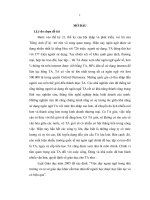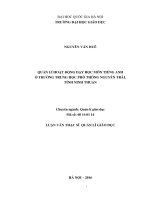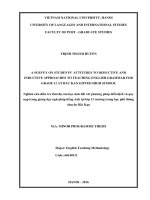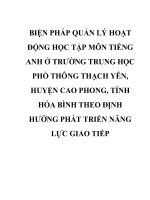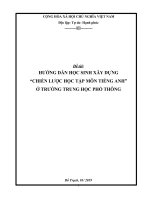Áp dụng đóng kịch trong các tiết học project môn tiếng anh ở trường trung học phổ thông chuyên bắc kạn
Bạn đang xem bản rút gọn của tài liệu. Xem và tải ngay bản đầy đủ của tài liệu tại đây (1.75 MB, 113 trang )
THAI NGUYEN UNIVERSITY
SCHOOL OF FOREIGN LANGUAGES
PHAN THI THU GIANG
AN APPLICATION OF DRAMA IN ENGLISH PROJECT LESSONS
IN BAC KAN GIFTED HIGH SCHOOL
(Áp dụng đóng kịch trong các tiết học “project” môn Tiếng Anh
ở trường THPT Chuyên Bắc Kạn)
M.A THESIS
Field: English Linguistics
Code: 8220201
THAI NGUYEN – 2019
THAI NGUYEN UNIVERSITY
SCHOOL OF FOREIGN LANGUAGES
PHAN THI THU GIANG
AN APPLICATION OF DRAMA IN ENGLISH PROJECT LESSONS
IN BAC KAN GIFTED HIGH SCHOOL
(Áp dụng đóng kịch trong các tiết học “project” môn Tiếng Anh
ở trường THPT Chuyên Bắc Kạn)
M.A THESIS
(APPLICATION ORIENTATION)
Field: English Linguistics
Code: 8220201
Supervisor: Dr. Nguyen Trong Du
THAI NGUYEN – 2019
CERTIFICATE OF ORIGINALITY
I, the undersigned, hereby certify my authority of the study project report entitled
“An application of drama in English project lessons in Bac Kan Gifted High
School” submitted in partial fulfillment of the requirements for the degree of Master
in English Language. Except where the reference is indicated, no other person’s
work has been used without due acknowledgement in the text of the thesis.
Thai Nguyen, July 2019
Phan Thi Thu Giang
Approved by
SUPERVISOR
Date: …………………………
ACKNOWLEDGEMENTS
The author of this minor study gratefully gives acknowledgement to all the
support and motivation during the time of doing this research.
First of all, I would like to express me sincere thanks and gratefulness to my
supervisor, Dr. Nguyen Trong Du. His kind support and helpful advice went
through the process of completion of my thesis. Without his instructions,
encouragement, and inspiration, the thesis would not have been done effectively.
I also acknowledge my thankfulness to my school principal, my colleagues,
and my students who directly took part in my thesis with kind assistance and
support.
Besides, I would like to express my thanks to the lecturers and my friends
whose kind help, care, motivation gave me strength during the time I spent in Thai
Nguyen.
My special thanks approve to my parents, my brothers, and my sister for
their endless love. I especially thank my Mother who had never stop loving and
encouraging me, and she, perhaps only watches me on my Master Thesis Defense
Day FROM THE HEAVEN.
ABSTRACT
English has become an indispensible tool in modern society, so teaching and
learning English have to be innovated to meet the more and more demanding
requirements. This minor thesis aims to investigate the attitude of the learners in a
gifted high school in the north of Viet Nam towards the application of drama in
project lessons as well as the influence of drama strategy on students’ speaking
performances and their soft skills development. The study is in the form of an action
research, which is believed to enable the researcher to investigate the participants
thoroughly and precisely. Qualitative and quantitative methods objectively supported
for the main findings of the study. The data instruments include questionnaires and
the researcher’s observation sheets. Some video recorded are involved as a part of
data for deeper observation and analysis. The results reveal that the majority of the
students felt interested in the applying of drama in project lessons. Moreover, most
students gained the improvement in their speaking competence in general. The main
finding of the study from the analysis of both students’ responses in the
questionnaires and teacher’s observation checklist was that students’ soft skills such
as team-building skill, problem-solving skill, and inter-personal skill improved
significantly. However, the results also point out that some students seemed to have
lost interest and motivation by the end of the project. It suggests that various
teaching strategies should be combined to gain effectiveness. This study also
provides some pedagogical implications for students, teachers, and other researchers
to study the application of drama in project lessons in a larger scope with bigger
population to reach more precise validity, reliability, and generalization.
LIST OF TABLES AND PICTURES
Chart 1: Student’s attitude towards the applying of drama in project lessons. ........34
Chart 2: Influence of drama on students’ speaking performances............................39
Chart 3: Influence of drama on students’ social skills ..............................................42
Picture 1a: Eagerly prepare for drama performance ................................................33
Picture 1b: Eagerly prepare for drama performance ................................................33
Picture 2: Drama performances.................................................................................36
Picture 3: Teambuilding spirit...................................................................................41
TABLE OF CONTENT
CERTIFICATE OF ORIGINALITY .......................................................................... i
ACKNOWLEDGEMENTS ....................................................................................... ii
ABSTRACT .............................................................................................................. iii
LIST OF TABLES AND PICTURES ...................................................................... iv
TABLE OF CONTENT ..............................................................................................v
CHAPTER 1: INTRODUCTION............................................................................1
1.1. Rationale of the study...........................................................................................1
1.2. Aims of the study .................................................................................................3
1.3. Research questions ...............................................................................................4
1.4. Scope of the study ................................................................................................4
1.5. The significance of the study ...............................................................................4
1.6. Method of study ...................................................................................................5
1.7. Design of the study...............................................................................................6
CHAPTER 2: LITERATURE REVIEW................................................................8
2.1. Cooperative Learning...........................................................................................8
2.2.
Project-based
..........................................................................................9
learning
2.3.
.................................................................................................................12
Drama
2.4. Drama activities as a strategy in teaching and learning language .....................14
2.4.1. Contextualizing
.........................15
language
and
providing
a
safe
environment
2.4.2. Sustainable, holistic learning ..........................................................................16
2.4.3. Improving personal and social competences ..................................................17
2.4.4. Motivation .......................................................................................................17
2.5.
.............................................................................................................17
Speaking
2.6. Teaching and learning English speaking skill....................................................19
2.7. Social skills ........................................................................................................24
CHAPTER 3: METHODOLOGY.........................................................................26
3.1. Research design..................................................................................................26
3.1.1. Qualitative method applied in the study .........................................................26
3.1.2. Quantitative method applied in the study .......................................................27
3.2. Application of drama in practical teaching context ...........................................27
3.3. Data collection instrument .................................................................................29
3.4. Data analytical method.......................................................................................30
3.4.1. Data analysis of questionnaires.......................................................................30
3.4.2. Data analysis of observation sheets and video clips .......................................30
CHAPTER 4: FINDINGS AND DISCUSSIONS .................................................32
4.1. The main findings of the study ..........................................................................32
4.1.1. The students’ attitude towards drama project lessons.....................................32
4.1.2. The influence of drama on students’ speaking performances.........................35
4.1.3. The influence of drama on students’ social skills. ..........................................40
CHAPTER 5: CONCLUSION AND IMPLICATIONS......................................44
5.1. The conclusion of the study ...............................................................................44
5.2. The limitation of the study .................................................................................45
5.3. The implications of the study. ............................................................................46
REFERENCES ........................................................................................................48
APPENDIX ..............................................................................................................55
CHAPTER 1: INTRODUCTION
1.1. Rationale of the study
These days, English has proven its indispensable role in each nation’s
development all over the world. It is English that help bridge the different races,
cultures, religions, politics, and society. In the world of globalization, English has
become a dominant language used and spoken both nationally and internationally.
There are a number of sectors where English is needed such as medicine, politics,
engineering, economy, tourism, finance, international relations, education etc.
English is not only important at a global scale but also at regional level like ASEAN
regions. It is stated in the ASIAN Charter article 34 that the means of
communication within ASEAN countries in the fields of government sectors as well
as other organizations related in both government and private sectors. Therefore,
English has shown its power when it becomes the first priority for the people of
ASEAN to create the relationship without borders in geography and culture, and the
world of competiveness. To turn English a second language of the nation, much
effort has been made in many ASIAN countries in order to improve their citizens’
English proficiency to meet the great demand of the modern world. Regarding the
foreign language teaching and learning in Viet Nam, English is considered the core
subject in the national curriculum. According to To (2010), the English capacity of
Vietnamese people is limited although there have been some positive changes in the
teaching context recently. It is reported by executive manager of Project 2020 that
98% of Vietnamese students study English for seven years (from grade 6 to grade
12, age 11–18), but cannot use it for basic communication (Nhan, 2013). With a
view to improving English language teaching and learning in Vietnam in the time of
industrialization and modernization, Prime Minister has announced Decision No.
1400/QĐ-TTg “Teaching and Learning Foreign Languages in the National
Education System, Period 2008 to 2020”. The general goal of this project is that “by
the year 2020 most Vietnamese youth whoever graduate from vocational schools,
colleges and universities gain the capacity to use a foreign language independently.
1
This will enable them to be more confident in communication, further their chance
to study and work in an integrated and multi-cultural environment with variety of
languages. This goal also makes language as an advantage for Vietnamese people,
serving the cause of industrialization and modernization for the country” (MOET,
2008). For the Gifted High School System, another decision is issued by MOET in
2010 (Decision No. 959/QD-TTg – “Developing The Gifted High School System,
Period 2010 to 2020”), which narrows the scope of the previous policy to gifted
schools only.
According to this Decision, from school year 2011-2012, natural
science subjects, including Mathematics, Physics, Chemistry, Biology and
Computer Science, will be taught totally in English in piloted gifted schools. The
implementation would be applied in the remaining gifted schools by 2015. It
requires not only teachers but also learners to innovate teaching and learning
process to reach this goal.
In the teaching context in Bac Kan province, a remote and mountainous area,
although most people are aware of the importance and the necessity of English, the
underdeveloped social economic condition has become a barrier in improving this
foreign language. In addition, the extreme lack of language speaking environment
results in students’ quite low English proficiency. In details, the results of the
National Examinations of Secondary Education in some recent years have shown
that only around 10% of the students could get mark from 5.0 in English. This fact
challenged both teachers and learners to innovate teaching and learning to meet the
demand of the country’s industrialization, modernization, and international
integration process.
Bac Kan Gifted high school was founded in 2003 and it has become a
trustworthy place where educated talented students for the province. However, for
students there, English is not their cup of tea and speaking English is a difficult
task. Most of the students are ethnic minority people and quite shy to speak English
in front of the others. Their English competence is pre-intermediate and they can
hardly have chances to communicate with English native speakers. Three forty fiveminute-lessons a week is time for practicing their speaking skill of most of the
students. Only a few of them have chance to interact with English speakers through
social networks. As a result, although they spent six or seven years studying English
at school, they have to make a great effort to pronounce an English sentence
correctly, and they are not confident enough to communicate in the target language.
They may understand the language and know a lot about its grammar and lexicon,
but when they need to speak, they seem to be at a loss for words or too shy to speak
in front of other people. Thus, their English scores in examinations were low.
Moreover, English proficiency is currently a barrier for most of them, which
disadvantages them from gaining prizes in some certain international competitions
partly due to misunderstanding the requirements and poor English performances.
Piloted English textbook, which was applied in Bac Kan Gifted high school
three years ago, is a new curriculum for both teachers and students. After each unit
in this textbook, there is a lesson named “project” at which teacher can create
different kinds of activities to help students develop their sub-skills. It is the time
when the learners have more chances to improve their speaking skill. That is the
reason why applying drama activities in teaching project lessons is selected as the
research issue with a hope to have an in depth study to reach the expected result,
which is whether drama as a technique of teaching speaking skill can help engage
the students in their learning, involve and motivate them to use their target language
in reality, as well as create the interest among learners. The research result may
suggest valuable implications in teacher’s further career as an English teacher.
1.2. Aims of the study
The study aims at investigating the attitude of grade 11 students towards the
applying of drama in English project lessons during the second term of the school
year 2018-2019; also the study’s main purpose is to find out whether drama can be
used as an effective teaching technique to enhance students’ speaking. Investigation
of the study may suggest important implications in teaching and learning English
not only in this class but also in others.
1.3. Research questions
The study attemps to answer two questions:
1. What are the attitudes of students towards the application of drama in project
lessons?
2. To what extent can drama project lessons influence students’ speaking
performances and social skills development?
1.4. Scope of the study
The study focuses on speaking skill, which is a challenge to both teachers
and students in such a remote and mountainous area where the teaching and
learning condition still face numerous difficulties. During the school year 20182019, the researcher was in charged of class 11A; therefore, she chose them as her
study participants for her convenience.
The study was conducted in the year 2019. The study began at the beginning
of the second semester of the school year 2018-2019 and was expected to be
completed by the end of that semester. The study involved the participants of 28
grade 11 students from class 11A in Bac Kan gifted high school. The selected
strategy, which is using drama, was applied in 05 Project lessons, each of which last
forty minutes. Since the students were studying the new English books, they had
one Project lesson after every unit. This was when the application of drama
activities took place. Then the data collection and analysis were carried out to reach
the findings.
The scope of the study includes the application of drama in project lessons in
only one circle of an action research. The observation to diagnostic the problems in
teaching and learning speaking skills is excluded from the scope of the study and
regarded as teacher’s experience in reality.
1.5. The significance of the study
With a view to investigate the attitude of students towards the applying of
drama activities in project lessons, the study is hoped to reveal students’ preference
in their ways approaching English speaking skill. Although drama is not a new
strategy in language teaching and learning, it is still expected to bring about certain
effectiveness in getting students involved in the lessons excitedly. Those who
benefit first from the study are learners because if the subjective expectation of the
researcher become positive, the students will participate more actively, will not be
nervous to speak English, be brave and confident to answer teachers’ questions, and
be able to communicate English well.
This will result in the improvement of
students’ speaking proficiency.
Furthermore, it is also hoped that the findings of the study make both
theoretical and practical contribution to the improvement of English teaching and
learning process, especially in teaching speaking.
In addition, teachers in Bac Kan Gifted High School are likely to receive
benefits from the information the research provides. The findings can be used as a
source of reference for teachers in their pedagogical aspect. Whether the findings of
the study are positive or negative, teachers in this school can have an overall insight
about the effectiveness of drama activities applied in their own school, and on their
students.
Finally, the study can give contribution to other researchers as references in
conducting further research either in the related theme or in others. Generally, the
significance of the study will be seen through the benefits it will bring to all parties
involved from students, teachers to educators and other researchers.
1.6. Method of study
This study was in the form of an action research in which both qualitative
and quantitative methods were employed. An action research was believed to enable
the researcher to investigate the participants thoroughly and precisely. Qualitative
and quantitative methods objectively supported for the main findings of the study.
Both methods were employed parallel and they were supportive of each other.
Quantitative and qualitative methods were merged to help gain reliability and
validity of the result.
The data instruments of the study included questionnaires to investigate the
attitude of students toward drama activities applied in project lessons and
observation sheets used by teacher during the application of drama activities in five
project lessons. After being collected, questionnaires about students’ attitude toward
drama activities used in project lessons were synthesized and analyzed
quantitatively. The video clips recording lessons were used for further analysis in
term of students’ behavior, participation, and improvement in their speaking
performance. Performances of units 6 and 9 were recorded since they were the first
and the nearly last units in the second term, so the achievements if there were would
be clear to be seen. Other Units, including units 7, 8, and 10, were observed and
noted.
Base on the analysis of the data collected, the main findings, conclusions, as
well as implications of the study were made with the hope to contribute to the
language teaching and learning process.
1.7. Design of the study
This minor thesis is divided into five chapters.
Chapter 1, INTRODUCTION, presents the rationale, the aims, research
questions, participants, scope of the study, significance, method, and design of the
study.
Chapter 2, LITERATURE REVIEW, presents various concepts most
relevant to the research topic such as project-based learning, cooperative learning,
drama activities, and speaking English skill. In addition, theoretical concept of
teaching and learning English speaking skill both in Viet Nam and in other
countries is presented in this part. It, moreover, mentions the previous studies on
drama activities as a strategy in language teaching and learning.
Chapter 3, METHODOLOGY, provides the methodology underlying the
study, which includes the general information about study subjects, the current state
of teaching and learning speaking at Bac Kan gifted high school. The focus of this
chapter includes the methods of data instruments, data collection, and introduces the
method of data analysis.
Chapter 4, FINDINGS AND DISCUSSIONS, presents the main findings of
the study, which are found base on the analysis of the data collected including
results from questionnaires and observation sheets.
Chapter 5, CONCLUSION AND IMPLICATIONS, summarizes the findings and
give some implications in which drama activities applied in the project lesson for
grade 11th English major students at Bac Kan gifted high School. This chapter also
points out the limitations of the study and provides some suggestions for
further studies.
CHAPTER 2: LITERATURE REVIEW
2.1. Cooperative Learning
Cooperative learning is a term referring to a strategy for group instruction. It
is one of teaching and learning strategies that follow learner-centered approach.
Different educators and researchers give this term diferent definitions.
In general, according to Slavin (1995,p.84) :
“Cooperative
students
learning
work
in
is
an
instructional program in which
small groups to help one another master
academic content.”
In more detail about forms of cooperation, Brown (1994, 192) supposes:
“Cooperative
learning
involves
students working together in
pairs or groups, and they share information .They are a team
whose
players must work together in order to achieve goals
successfully.”
Additionally,
Kessler
(1992,p.131)
gives
the
definition
of
cooperative learning particularly in language learning context as follow:
“Cooperative
learning
is
a
within-class grouping of students
usually of differing levels of second language proficiency, who learn
to work together on specific tasks or projects in such a way that
all students in the group benefit from the interactive experience.”
According to D. Johnson and R. Johnson (2000), cooperative learning is
defined as a successful teaching strategy in which students work in small groups to
contribute diferent ideas to achieve the learning objective.
Regarding the benefits that cooperative learning brings to the learners, it
can be summarized as following:
Academically, cooperative learning may help maximize the learning ability
since by working together; the students can discuss, finish and submit the required
task. Through cooperative learning, students have more chances to use the target
language as well as construct their own language because it both requires and gets
students involved in communication. In term of speaking skill, cooperative learning
enables students to actively build up their own concept to communicate
their opinions with others (Isjoni, 2011). Since the target language is used more
frequently, students’ speaking competence is more likely to be enhanced.
Socially, cooperative learning helps students identify the problem and find
out the solutions to it. Thus, in a cooperative learning classroom, students
have more chances “to discuss with peers, present and defend their ideas,
exchange diverse beliefs, question other conceptual frameworks, and be actively
engaged in the learning process” (Brown, 2011). It is time when problem – solving
skill is formed and developed. Besides, through group meeting and discussing,
each member may have a chance to build up their team working skill. Also,
students can gain improvement in their interpersonal skill through exchanging and
processing information and reaching the final conclusion. The most important
benefit is that cooperative learning creates the environment for students to
develop their critical thinking- one of the most significant qualifications of the
young in the 21st century.
When learning speaking skill with drama strategy, students have to use
cooperative skill during the learning process, from deciding the script, dividing the
roles, planning schedule for rehearsals, selecting costumes, to performing. If the
students do not take strong responsibility in group work and do not co-work
effectively with other members, their results can not be satisfied. In other words,
to achieve the goal, students must share, support, and co-work smoothly.
To put it in the nutshell, with both academic and social benefits,
cooperative learning is a promise learning strategy to apply in the modern world of
development and globalization trends.
2.2. Project-based learning
Project-based learning is an instructional model that involves students in
investigations of compelling problems that result in authentic products. The
original of Project is derived from Pragmatism, which, according to Frey (1986), is
the philosophical movement, which appeared in the middle of the 19th century
Số hóa bởi Trung tâm Học liệu và Công nghệ thông tin – ĐHTN
and promotes action and practical application of knowledge in everyday life.
The implementation of the project method was based on three pedagogical
principles
Số hóa bởi Trung tâm Học liệu và Công nghệ thông tin – ĐHTN
(Crisafidis, 2005), among which learners’ active participation in the learning
process plays the key role.
Projects are believed to help create stronger classroom learning
opportunities. For students, benefits of project-based learning are mainly on the
following points. First and foremost, it helps increase attendance, growth in selfreliance, and improved attitudes toward learning (Thomas, 2000). Taking part in
project, students have more chances to access to a quite-diferent-from-traditional
learning method. They are likely to pay more attention to learning process as well
as get motivated in doing the projects. Secondly, while participating in projects,
students take greater responsibility for their own learning than during more
traditional classroom activities (Boaler, 1997; Railsback, 2002). The reason is that
Projects put students in different active roles such as: problem solver, decision
maker, investigator, or documentarian. Hence, students have to work responsibly
to complete their duty. A further benefit is that students have enhanced
motivation, engagement and enjoyment (Lee, 2002). From a motivational
perspective, projects being authentic tasks, are more meaningful to students,
increase interest, motivation to participate, and can promote learning (Brophy,
2004). Enjoyment and motivation also stem from the fact that classroom language
is not predetermined, but depends on the nature of the project (Larsen-Freeman,
2000:149). One more benefit students get from doing projects is that they are
provided with a variety of opportunities to develop complex skills, such as higherorder thinking, problem solving, collaborating, and communicating (SRI, 2000).
Joining a project means working in groups, so students will learn to co-work to
reach the goal. It is believed that students can develop their social and soft skills
very well such as group working skill, interpersonal skill, problem-solving skill.
According to Allen (2004), among those skills, the development of problem-solving
and higher order critical thinking skills are very important, since they are life-long,
transferable skills to settings outside the classroom. Last but not least, projectbased learning allows students to access to a broader range of learning
Số hóa bởi Trung tâm Học liệu và Công nghệ thông tin – ĐHTN
opportunities in the classroom, providing a strategy for engaging culturally diverse
learners (Railsback, 2002)
Số hóa bởi Trung tâm Học liệu và Công nghệ thông tin – ĐHTN
In terms of benefits for teachers, the implementation of project-based
learning helps them to improve professionalism and collaboration among
colleagues, and create more opportunities to build relationships with students
(Thomas, 2000). Besides, introducing a wider range of learning opportunities into
the classroom for diverse learners also make teachers pleased.
Steps of Project Development
Step1: Starting the project
Each project often starts with a question or a problem that needs tackling.
Through the analysis of the factual teaching and learning context as well as the
requirement of the curriculum in each unit, teacher will raise a question or
a problem for students to address. After the teacher and the students agree
upon the theme of the project, they will determine the outcome, and figure out
project details that guide students from the opening activity to the completion
of the project. At this step, students consider their roles, responsibilities, and
collaborative work groups.
Step 2: Developing the project
In this step, after receiving the requirement, students are divided into
groups. Each group’s members meet and arrange the timing for gathering, sharing,
and compiling information, and then prepare to present their final project.
Step 3: Reporting the project
In this step, students present their outcome of their project, as planned.
Step 4: Assessing the project
The students reflect the project theme on the target language. They are
also asked to make recommendations that can be used to improve their projects
in the future. The teachers provide students with feedback on their language and
content learning. Peer feedback is sometimes useful for both the presenters and
the audiences.
In the new English textbook, there is a project lesson at the end of each
unit. This part is aimed at providing students with an opportunity to apply the
Số hóa bởi Trung tâm Học liệu và Công nghệ thông tin – ĐHTN
language and skills they have learnt throughout the unit to perform a task in
a real-life
Số hóa bởi Trung tâm Học liệu và Công nghệ thông tin – ĐHTN




